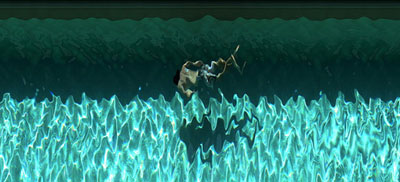
Jay Mark Johnson »
Spacetime
Exhibition: 16 Jul – 29 Aug 2009
ACE Gallery Beverly Hills
9430 Wilshire Blvd, Beverly Hills
CA 90210 Los Angeles
+1-310-8589090
acegallery@acegallery.net
www.acegallery.net
Tue-Sat 10-18
Ace Gallery presents a selection of photographic artworks by Jay Mark Johnson spanning four series: Motion Studies, Anachronistic Nature, Topological Shifts, and Spacetime Cityscapes and Landscapes. Johnson produces photographic images that challenge the norms of perception. Employing a process that is distinct from conventional photography, he creates works that merge the recording of space and time into a single, linear "spacetime" continuum. The resulting photographs are akin to both seismographs and electrocardiograms in that, as timelines, they begin on the left and end on the right. The horizontal length of the image conveys an uninterrupted and fluid measurement of a brief span of time, varying in duration from 10 seconds up to 45 minutes. Johnson approaches this work as an open-ended exploration into the possibilities for timeline photography. In his Motion Studies series, the artist registers the free-flowing movements of Taichi dancers, ballet dancers and swimmers. The resulting images appear as gesture-driven "action paintings." His Anachronistic Nature series records familiar patterns of natural movement that have been transposed into singular, two dimensional time sequences. "Nature" is recognizable but appears to be out of sync with itself. With his Topological Shifts he focuses on transformations that occur when a non-linear movement is re-rendered into a straight line graphic. The giant circular steel latticework of an amusement park ferris wheel is unwrapped into a delicate linear scaffolding. But it is within his Spacetime Cityscapes and Landscapes that Johnson’s most inventive and interpretive developments have flourished. Art historian Christopher Finch writes, "Moving objects are frozen against a background that has been dissolved by the camera into horizontal bands of color spanning from edge to edge of the picture plane. The places rendered by Johnson in his Spacetime Landscapes and Cityscapesare devoid of topography and without landmarks. They are unique in the canon of landscape imagery in that they must be conjured into existence, in the imagination of the viewer, by the events that unfold in front of them—the readily decodable passage of people, animals, bicycles, baby carriages, cars or trains—since these events imply the existence of a place to provide them with context." The settings for this series are international in scope. They include Belgrade (Serbia), Cetona (Italy), Hamburg (Germany), Hazard (Kentucky), Hong Kong, Los Angeles, Moscow, Paris, Rome, and Valencia (Spain). At each new location, Johnson develops an increasingly critical interplay between the place itself, its unique position in history and the unconventional visualizations that he creates. His cultural, linguistic and political references are far reaching and he applies them with incisive wit. "Since he began his studies in 2005," continues Finch, "Johnson has already uncovered many possibilities, demonstrating that the process can be employed to record a wide variety of subjects/events. Perhaps the most exciting aspect of his photography is that it tugs photography away from the gravitational pull of Euclidean documentation - which has dominated the field since its beginnings - and prods it towards new and ambitious aesthetic and intellectual goals" Johnson writes, "Human knowledge expands and matures through advances in the arts and the sciences in one of at least two general manners. Either they push the outer envelope into newer territory or they construct new symbolic scaffoldings which span across and link together previously disparate disciplines. In the empirical sciences, discernible advances are made when an established instrument or practice develops greater refinement or greater range. Art contributes by challenging perceptions, shifting perspectives or otherwise strengthening or broadening established understandings." The artist views the works in these series as spacetime photography. He equates his visual experimentation to stepping "through the looking glass" with Alice. In this parallel world of shifted perceptions, the ground rules are changed. Horizontal space is obliterated, shadows are crisscrossed, directional movement is confounded. Individuals appear isolated from the spaces they inhabit, and the relative speed of an object causes its expansion or contraction. Though the images are true photographs, they challenge the viewer’s effort to decode them. Born in 1955 in St. Petersburg, Florida, Jay Mark Johnson holds a Master’s Degree in Architecture from Tulane University. He studied at the Institute for Architecture and Urban Studies (NYC) and UCLA where he focused on Linguistic Anthropology and Biological Anthropology. Through the early 1980s, his associations with architects Peter Eisenman, Rem Koolhaas, Aldo Rossi and Lebbeus Woods allowed him to explore questions of representation and time in both built and conceptual architecture. Beyond architecture, Johnson's varied and prolific career spans theatre and performance art, photography, live musical performance, and journalism. In the 1980s, Johnson’s collaborative performances included presentations at downtown Manhattan venues: The Kitchen, The Pyramid Club, and The Henry Street Settlement. During the latter half of the eighties, he co-founded three alternative television collectives, first in Manhattan, and then in Mexico and El Salvador at the height of political repression and unrest in those countries. After his return from Latin America he worked within the film industry and is now a cinema director with broad experience in visual effects production, having supervised, directed or otherwise contributed to the computer generated imagery for a dozen major studio films and television series, such as Outbreak, The Matrix, Titanic, Tank Girl, Moulin Rouge, and White Oleander and music videos for Michael Jackson, Madonna, Red Hot Chili Peppers and others. He lives and works in Venice, California.